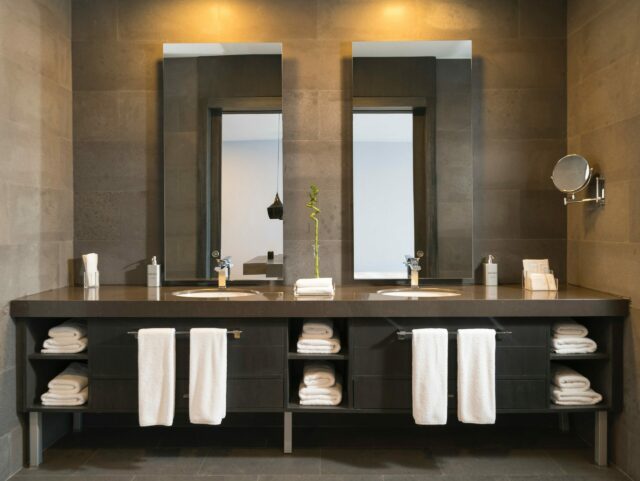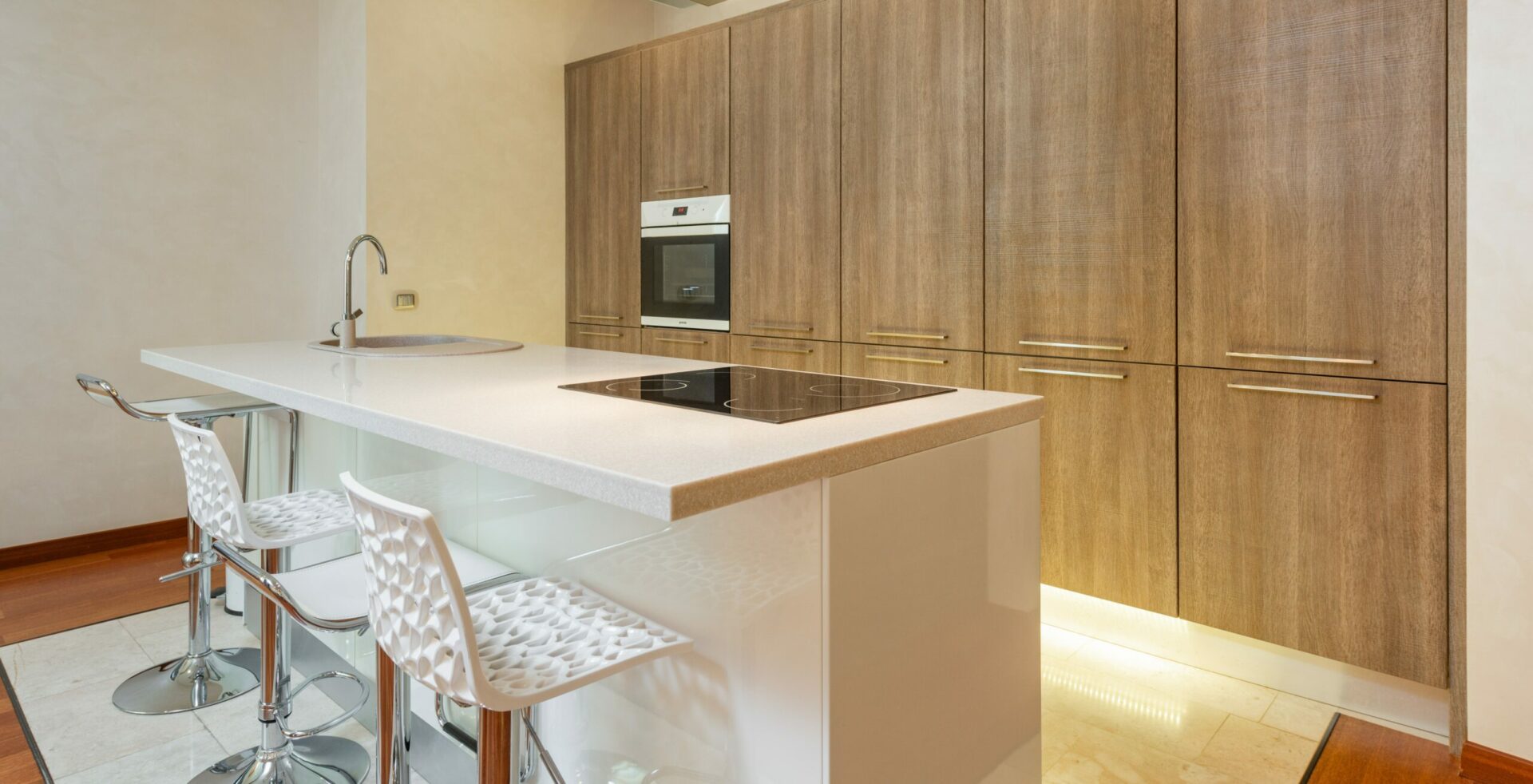Why Do Bathroom Vanities Have Legs?
| The legs added to bathroom vanities help to raise the cabinet, in turn transforming the bathroom vanity into a beautiful piece of furniture. They also make installation of the vanity much easier, as it can be easily moved without trouble from one place to another. Besides, the addition of legs make the height of the vanity adjustable and create more room for open shelf storage. |

RELATED = = = > Is it Cheaper to Buy a Premade Vanity?
Consider into detail each of the benefits provided by bathroom vanity legs:
1. Ease of Installation
Ease of installation is the biggest advantage associated with bathroom vanity legs. Simply put, vanities that have legs attached to them are much easier to install than those without. Unlike wall mounted vanities, you will not need to worry about stud placements or factors such as the weight of the vanity and the strength of the bathroom wall.
Also, vanities that have legs have simple installation processes that won’t require you to call a professional, as opposed to the lengthy and tedious process of installing wall mounted vanities. After all, all you will need to do is to set the vanity piece in place, just like you would with any other piece of furniture.
2. Ease of Moving
Having legs on your bathroom vanity would also make it easier to move it from one place to another. For example, unlike with a wall mounted vanity, you won’t be forced to call a carpenter to detach the bathroom vanity from the wall each time you are relocating. Such convenience and easy mobility of bathroom vanities with legs make them a popular choice especially among renters.
3. Adjustable Height
Some bathroom vanities come with legs whose heights can be easily adjusted. The adjustable height of the legs make it possible to increase or decrease the height of the vanity as desired. For example, it could be that the vessel sink is placed too far up, making it quite uncomfortable for you to use. In such a case, you could adjust the legs in such a way that the height of the vanity matches the height of the sink perfectly. The adjustable legs would also come in handy if the sink was a little too down for you. The point is, adjustable legs allow you to set the bathroom vanity at the height just ideal for you!
4. Open Shelf Storage
Even when legs are installed, bathroom vanities still leave an open space underneath them. The space between the legs and the cabinets provide more room for storage. Besides, the legs themselves could have intricate designs that add to the visual appeal. You may opt to keep items such as scales in the additional storage space created underneath the vanity.
RELATED = = = > Should a Bathroom Vanity Be Centered?
Main Types of Bathroom Vanity Legs
There are two types of legs for bathroom vanities:
A. 4-leg Bathroom Vanity
As its name suggests, a 4-leg bathroom vanity has 4 firm stands installed on the base. With four legs, the vanity can be freestanding and does not have to be mounted or attached to the wall. Even so, just because 4-leg bathroom vanities are freestanding does not mean that they can be moved and placed anywhere in the bathroom. Remember, there is still the drainage and plumbing to keep in mind, which will most probably force you to place the vanity against the wall. After all, you want to hide and protect the plumbing system and keeping the vanity against the wall is the only way you can achieve this.
When it comes to the installation process, 4-leg bathroom vanities are very easy to install. As they are freestanding, these vanities do not require any mounting or attaching to the wall. Besides, the additional legs provide enough support, eliminating the need for support brackets. The easy installing process of the vanities make these a cheaper and time-saving option for bathroom vanities.
B. 2-leg Bathroom Vanity
Unlike a 4-leg bathroom vanity which is usually freestanding, a 2-leg vanity cannot support itself firmly. Therefore, it needs to be mounted to the bathroom wall for more support. This makes the installation process for these types of vanities more expensive and time-consuming, as you will have to spend time drilling into the walls and securing the sinks with screws.
Also, support brackets are mandatory when installing a 2-leg bathroom vanity. These brackets work to support the sink and ensure that it is mounted firmly and effectively on the wall. And to make sure that the sink is installed evenly, it is recommended that you always use a level for this process.
Adding Adjustable Legs and Toekick to the Bathroom Vanity
How to Add Legs to a Bathroom Vanity Without Legs?
Even though many bathroom vanities are freestanding, they come with legs which can be easily attached to the base. Adding the legs not only gives the vanity a contemporary and traditional look, but also complements the overall design of the structure.
The good news is, when it comes to adding legs to bathroom vanities, you do not need to hire a professional for the job. You can easily do the job yourself, provided you have ready-made (or manufactured) legs that can be screwed into the brackets at the vanity’s bottom. Here is the step-by-step procedure on how to add legs to a bathroom vanity without legs:
1. Remove everything from the bathroom vanity, including the drawers and cabinets. Lay the vanity on its back, then set up a cordless drill or power that has screw-tip attachment.
2. At the rim of the bathroom vanity, install a furniture-leg bracket at all corners. The rim is usually located at the underside of the bathroom vanity. It is recommended that you use wood screws measuring 1 inch at all the machine holes at the base of the bracket.
3. Attach a metal insert shank at the top of the furniture leg. To achieve this, screw the lag-thread end of the shank into the pilot hole. Using adjustable pliers, hold the unthreaded portion at the shank’s center. Be careful not to hold the upper hand with the pliers as this could lead to damaging of the machined threads. Then, tighten the metal insert shank, doing so in a clockwise direction. Repeat this step to attach the shank to the other remaining legs.
RELATED = = = > What is the Most Popular Color for a Bathroom Vanity?
4. Screw the threaded part of the metal insert shank into the bracket’s center via the threaded hole. Tighten it by hand, following a clockwise direction. Repeat this step to attach the remaining legs into their respective brackets.
5. Lift the bathroom vanity upright, then position it at your preferred location in the bathroom. If the vanity is too heavy, you could always ask someone else to help you lift it up.
FAQ
Can I Put Legs on a Wall-Mounted Vanity?
Yes, you can put legs on your wall mounted vanity. Once you have installed the legs, you can then set the vanity in place, just like you would with any other furniture pieces. Adding legs to wall mounted vanity will make it easier to move it and adjust it to your preferred height, if adjustable legs are used.
How Can I Level a Bathroom Vanity Without Adjustable Legs?
Not all bathroom vanities come with adjustable legs. If your vanity’s legs are not adjustable, you can place shims under the base to keep the vanity in level position.
Conclusion
If you were wondering why do bathroom vanities have legs, we hope you found this informational article helpful with the numerous advantages that vanities with legs have, and even if you don’t have legs on your vanity and would like to add them follow our step by step guide and you should be good to go!
READ ME NEXT = = = > Can I Leave the Dryer Running When I am Not Home?






